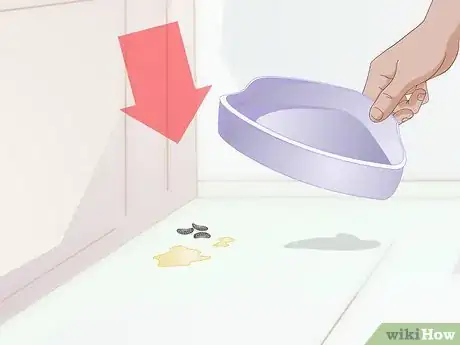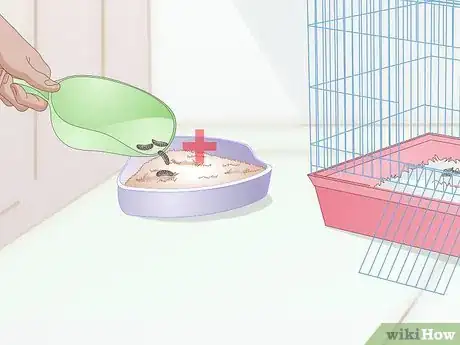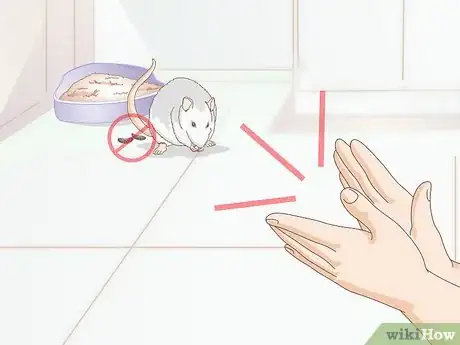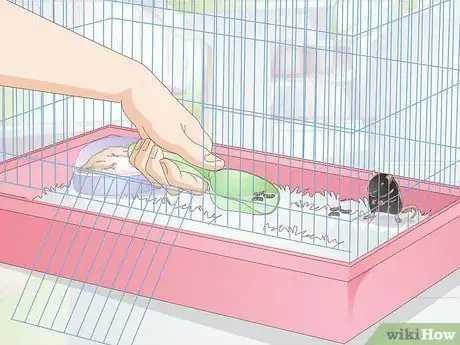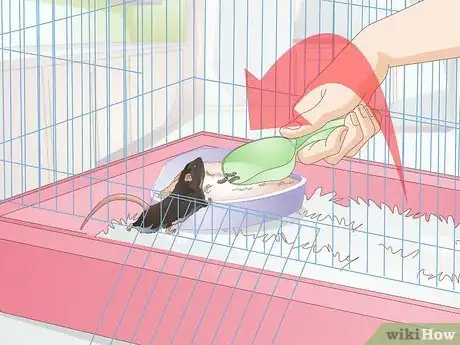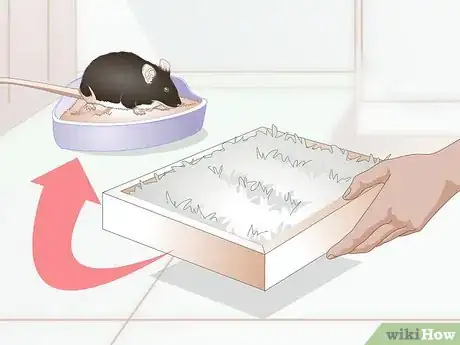This article was co-authored by Pippa Elliott, MRCVS. Dr. Elliott, BVMS, MRCVS is a veterinarian with over 30 years of experience in veterinary surgery and companion animal practice. She graduated from the University of Glasgow in 1987 with a degree in veterinary medicine and surgery. She has worked at the same animal clinic in her hometown for over 20 years.
wikiHow marks an article as reader-approved once it receives enough positive feedback. In this case, 91% of readers who voted found the article helpful, earning it our reader-approved status.
This article has been viewed 98,156 times.
Litter box training a pet rat has many advantages. If your rat eliminates in the same spot in the cage, this will make it easier to remove droppings and urine from the cage. To litter train a rat, set up the litter box in the part of the cage where your rat tends to eliminate. Praise your rat when you see it using the litter box. Once the rat is trained, maintain a clean litter box so the rat continues to use its litter box.
Steps
Setting Up the Litter Box
-
1Select the proper container for a litter box. You want to make sure your rat can comfortably climb in and out of a litter box. Pick a container fairly low to the ground. It should also be wide enough that your rat can fit inside easily.[1]
- It's best to purchase a litter box that can attach to the side of the cage. This way, the rat can't move the box around. You can buy one online or at a local pet store.
- If you don't want to purchase a box, you can use something like a small Tupperware container instead.
-
2Place the box in the right location. Observe where your rat typically goes to the bathroom. Rats usually urinate and defecate in a particular corner. Place the box near this space, as this encourages the rat to use the box.[2]
- If you have multiple rats, you may find urine and droppings in multiple places in the cage. Use more than one litter box, setting each box near the places you typically find urine and droppings.
Advertisement -
3Select a material to use in the litter box. You want a material different from the rat's regular bedding. This will signify the box is to be used for something different than day-to-day activity. At a local pet store, browse the variety of rat bedding. Choose a type of bedding you do not use in your rat's main cage. Fill the litter box with this bedding.[3]
-
4Make the litter box dirty. Rats may be initially confused and standoffish about the litter box. To make sure they know what it's for, collect droppings from the cage. Put them in the litter box. The rats will smell the droppings and go towards the litter box when they need to eliminate.[4]
- Make sure to wear gloves when handling rat droppings. Wash your hands afterwards.
Encouraging Your Rat to Use the Litter Box
-
1Praise your rats for using the litter box. While you can't watch your rat all the time, observe it when you can. When you see your rat using the litter box, offer praise. You can also offer a small treat as a reward.[5]
- Be as consistent as you can. Reward the rat each time you see it using the litter box.
- With time, you should find less and less droppings outside the box.
-
2Discourage the rats from eliminating outside the litter box. You do not want to yell at or punish a rat for eliminating outside the litter box. The rat will not understand why it's being scolded and this will only create tension. However, correct the rat gently when you see it going outside the box.[6]
- Do something to distract the rat. Simply try something like clapping your hands and saying "No" in a firm voice.
- Make sure not to raise your voice when saying "No."
-
3Be vigilant about keeping the rest of the cage clean. Your rat needs to understand there is a clear difference between its living space and its bathroom space. This way, it is less likely to eliminate outside the litter box. Make sure to clean up droppings and wet spots as soon as you see them.[7]
- When first litter training your rat, spot clean the cage a few times a day. As your rat gets more used to using the litter box, you can go back to a regular cleaning schedule.
-
4Place some droppings in the litter box. If your rat is really struggling to learn, remind it what the litter box is for. When spot cleaning, dump some of the waste you collect into the litter. This will help your rat understand he should eliminate inside of the box.[8]
Avoiding Missteps
-
1Maintain a clean litter box. Once your rat is eliminating in the box consistently, keep it clean. Like cats, rats may stop using a dirty litter box. Once a day, dump out the litter box and put down a fresh layer of bedding.[9]
-
2Use multiple litter boxes for a cage with many levels. Some rat cages are very large and have multiple levels. If your rat has this kind of cage, it's unlikely to go up or down stairs when it needs to use the bathroom. Therefore, keep a litter box on each level of the cage.[10]
-
3Change the litter box size as needed. If you started litter training your rat when it was a baby, it will eventually grow out of its box. A litter box needs to be big enough that your rat can comfortably fit inside. As your rat grows, swap out the litter box as needed.[11]
References
- ↑ http://www.burgesspetcare.com/rats/training/
- ↑ http://www.burgesspetcare.com/rats/training/
- ↑ http://www.burgesspetcare.com/rats/training/
- ↑ http://www.burgesspetcare.com/rats/training/
- ↑ http://www.dapper.com.au/articles.htm#litter
- ↑ http://www.dapper.com.au/articles.htm#litter
- ↑ http://www.joinrats.com/ModifyBehavior/LitterBox/
- ↑ http://www.burgesspetcare.com/rats/training/
- ↑ http://www.burgesspetcare.com/rats/training/
About This Article
To litterbox train your rat, start by purchasing a litterbox that attaches to the side of the cage so the rat can't knock it over. Then, fill it with a different bedding material than what you use for the rest of the cage to help your rat realize what the box is for. Additionally, gather up droppings from the cage and place them in the box so your rat can smell them, which will encourage it to use the litterbox. Whenever you see your rat use the litterbox, reward it with a treat to help it develop a positive association with the box. For tips on how to litterbox train a rat in a cage with multiple levels, keep reading!

